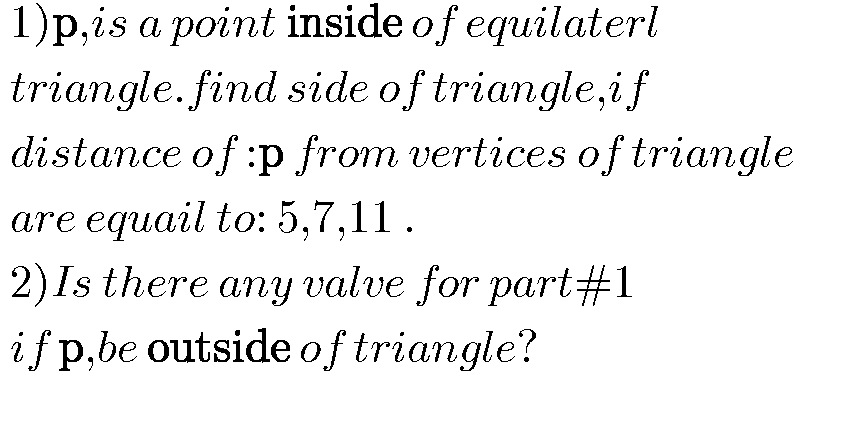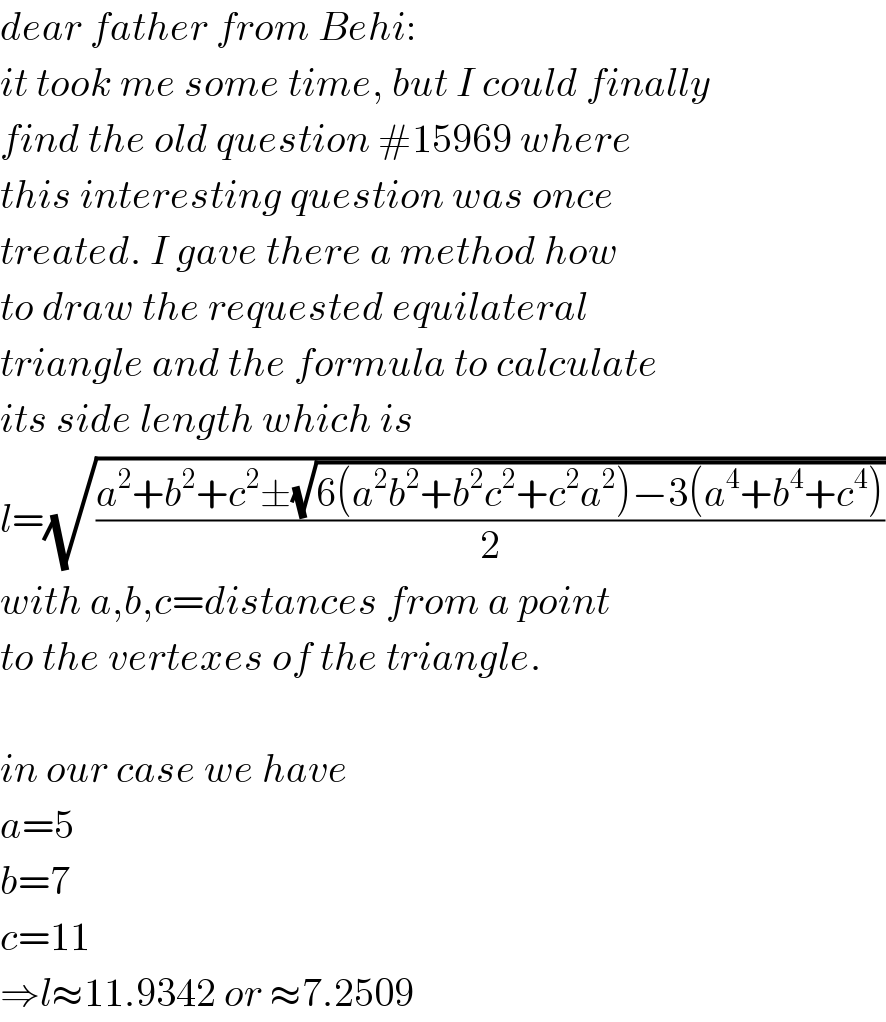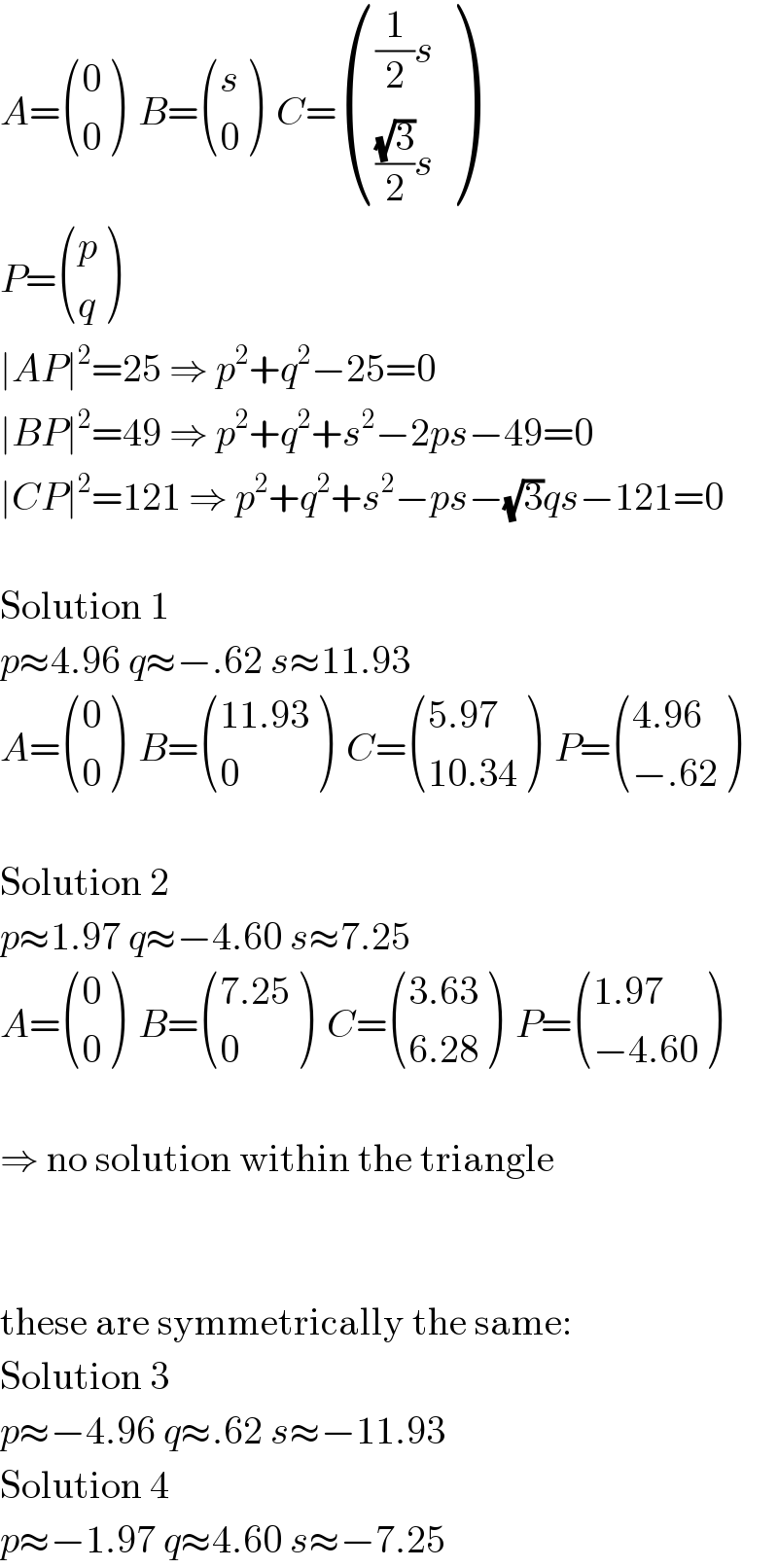Question Number 47657 by behi83417@gmail.com last updated on 12/Nov/18

Commented by mr W last updated on 13/Nov/18

$${dear}\:{father}\:{from}\:{Behi}: \\ $$$${it}\:{took}\:{me}\:{some}\:{time},\:{but}\:{I}\:{could}\:{finally} \\ $$$${find}\:{the}\:{old}\:{question}\:#\mathrm{15969}\:{where} \\ $$$${this}\:{interesting}\:{question}\:{was}\:{once} \\ $$$${treated}.\:{I}\:{gave}\:{there}\:{a}\:{method}\:{how} \\ $$$${to}\:{draw}\:{the}\:{requested}\:{equilateral} \\ $$$${triangle}\:{and}\:{the}\:{formula}\:{to}\:{calculate} \\ $$$${its}\:{side}\:{length}\:{which}\:{is} \\ $$$${l}=\sqrt{\frac{{a}^{\mathrm{2}} +{b}^{\mathrm{2}} +{c}^{\mathrm{2}} \pm\sqrt{\mathrm{6}\left({a}^{\mathrm{2}} {b}^{\mathrm{2}} +{b}^{\mathrm{2}} {c}^{\mathrm{2}} +{c}^{\mathrm{2}} {a}^{\mathrm{2}} \right)−\mathrm{3}\left({a}^{\mathrm{4}} +{b}^{\mathrm{4}} +{c}^{\mathrm{4}} \right)}}{\mathrm{2}}} \\ $$$${with}\:{a},{b},{c}={distances}\:{from}\:{a}\:{point}\: \\ $$$${to}\:{the}\:{vertexes}\:{of}\:{the}\:{triangle}. \\ $$$$ \\ $$$${in}\:{our}\:{case}\:{we}\:{have} \\ $$$${a}=\mathrm{5} \\ $$$${b}=\mathrm{7} \\ $$$${c}=\mathrm{11} \\ $$$$\Rightarrow{l}\approx\mathrm{11}.\mathrm{9342}\:{or}\:\approx\mathrm{7}.\mathrm{2509} \\ $$
Commented by MJS last updated on 13/Nov/18

$$\mathrm{great}! \\ $$$$\mathrm{but}\:\mathrm{how}\:\mathrm{to}\:\mathrm{decide}\:\mathrm{if}\:\mathrm{the}\:\mathrm{given}\:\mathrm{point}\:\mathrm{is}\:\mathrm{inside} \\ $$$$\mathrm{our}\:\mathrm{outside}\:\mathrm{the}\:\mathrm{triangle}\left(\mathrm{s}\right)? \\ $$
Commented by behi83417@gmail.com last updated on 13/Nov/18

$${i}\:{have}\:{no}\:{words}\:{to}\:{say}\:{master}. \\ $$$${i}\:{just}\:{say}\:{thanks}\:{in}\:{advance}\:{sir}. \\ $$$$……{and}\:{memories}\:{attack}! \\ $$
Commented by mr W last updated on 11/Feb/20
![to see if the point p is inside or outside the triangle, we calculate the angles between a and b, b and c as well as c and a. if all of these angles are obtuse, then point p lies inside. if at least one of these angles is acute, then point p lies outside. in our example: with l=11.9342 cos α=((b^2 +c^2 −l^2 )/(2bc))⇒α=79.7°<90° cos β=((c^2 +a^2 −l^2 )/(2ca))⇒β=88.1°<90° cos γ=((a^2 +b^2 −l^2 )/(2ab))⇒γ=167.8° ⇒p is outside. with l=7.2509 cos α=((b^2 +c^2 −l^2 )/(2bc))⇒α=40.3°<90° cos β=((c^2 +a^2 −l^2 )/(2ca))⇒β=31.9°<90° cos γ=((a^2 +b^2 −l^2 )/(2ab))⇒γ=72.2°<90° ⇒p is outside. [conclusion not correct, needs to be amended...]](https://www.tinkutara.com/question/Q47701.png)
$${to}\:{see}\:{if}\:{the}\:{point}\:{p}\:{is}\:{inside}\:{or}\:{outside} \\ $$$${the}\:{triangle},\:{we}\:{calculate}\:{the}\:{angles} \\ $$$${between}\:{a}\:{and}\:{b},\:{b}\:{and}\:{c}\:{as}\:{well}\:{as} \\ $$$${c}\:{and}\:{a}.\:{if}\:{all}\:{of}\:{these}\:{angles}\:{are} \\ $$$${obtuse},\:{then}\:{point}\:{p}\:{lies}\:{inside}. \\ $$$${if}\:{at}\:{least}\:{one}\:{of}\:{these}\:{angles}\:{is}\:{acute}, \\ $$$${then}\:{point}\:{p}\:{lies}\:{outside}. \\ $$$${in}\:{our}\:{example}: \\ $$$${with}\:{l}=\mathrm{11}.\mathrm{9342} \\ $$$$\mathrm{cos}\:\alpha=\frac{{b}^{\mathrm{2}} +{c}^{\mathrm{2}} −{l}^{\mathrm{2}} }{\mathrm{2}{bc}}\Rightarrow\alpha=\mathrm{79}.\mathrm{7}°<\mathrm{90}° \\ $$$$\mathrm{cos}\:\beta=\frac{{c}^{\mathrm{2}} +{a}^{\mathrm{2}} −{l}^{\mathrm{2}} }{\mathrm{2}{ca}}\Rightarrow\beta=\mathrm{88}.\mathrm{1}°<\mathrm{90}° \\ $$$$\mathrm{cos}\:\gamma=\frac{{a}^{\mathrm{2}} +{b}^{\mathrm{2}} −{l}^{\mathrm{2}} }{\mathrm{2}{ab}}\Rightarrow\gamma=\mathrm{167}.\mathrm{8}° \\ $$$$\Rightarrow{p}\:{is}\:{outside}. \\ $$$${with}\:{l}=\mathrm{7}.\mathrm{2509} \\ $$$$\mathrm{cos}\:\alpha=\frac{{b}^{\mathrm{2}} +{c}^{\mathrm{2}} −{l}^{\mathrm{2}} }{\mathrm{2}{bc}}\Rightarrow\alpha=\mathrm{40}.\mathrm{3}°<\mathrm{90}° \\ $$$$\mathrm{cos}\:\beta=\frac{{c}^{\mathrm{2}} +{a}^{\mathrm{2}} −{l}^{\mathrm{2}} }{\mathrm{2}{ca}}\Rightarrow\beta=\mathrm{31}.\mathrm{9}°<\mathrm{90}° \\ $$$$\mathrm{cos}\:\gamma=\frac{{a}^{\mathrm{2}} +{b}^{\mathrm{2}} −{l}^{\mathrm{2}} }{\mathrm{2}{ab}}\Rightarrow\gamma=\mathrm{72}.\mathrm{2}°<\mathrm{90}° \\ $$$$\Rightarrow{p}\:{is}\:{outside}. \\ $$$$ \\ $$$$\left[{conclusion}\:{not}\:{correct},\:{needs}\:{to}\:{be}\right. \\ $$$$\left.{amended}…\right] \\ $$
Commented by MJS last updated on 13/Nov/18

$$\mathrm{thank}\:\mathrm{you} \\ $$
Commented by MJS last updated on 14/Nov/18

$${l}=\sqrt{\frac{{a}^{\mathrm{2}} +{b}^{\mathrm{2}} +{c}^{\mathrm{2}} \pm\sqrt{\mathrm{6}\left({a}^{\mathrm{2}} {b}^{\mathrm{2}} +{b}^{\mathrm{2}} {c}^{\mathrm{2}} +{c}^{\mathrm{2}} {a}^{\mathrm{2}} \right)−\mathrm{3}\left({a}^{\mathrm{4}} +{b}^{\mathrm{4}} +{c}^{\mathrm{4}} \right)}}{\mathrm{2}}}= \\ $$$$=\sqrt{\frac{{a}^{\mathrm{2}} +{b}^{\mathrm{2}} +{c}^{\mathrm{2}} \pm\sqrt{\mathrm{3}\delta}}{\mathrm{2}}};\:\delta=\left({a}+{b}+{c}\right)\left({a}+{b}−{c}\right)\left({a}−{b}+{c}\right)\left(−{a}+{b}+{c}\right) \\ $$
Commented by mr W last updated on 14/Nov/18

$${thanks}\:{for}\:{this}\:{easy}\:{to}\:{remember}\: \\ $$$${form}! \\ $$
Answered by MJS last updated on 13/Nov/18

$${A}=\begin{pmatrix}{\mathrm{0}}\\{\mathrm{0}}\end{pmatrix}\:\:{B}=\begin{pmatrix}{{s}}\\{\mathrm{0}}\end{pmatrix}\:\:{C}=\begin{pmatrix}{\frac{\mathrm{1}}{\mathrm{2}}{s}}\\{\frac{\sqrt{\mathrm{3}}}{\mathrm{2}}{s}}\end{pmatrix} \\ $$$${P}=\begin{pmatrix}{{p}}\\{{q}}\end{pmatrix} \\ $$$$\mid{AP}\mid^{\mathrm{2}} =\mathrm{25}\:\Rightarrow\:{p}^{\mathrm{2}} +{q}^{\mathrm{2}} −\mathrm{25}=\mathrm{0} \\ $$$$\mid{BP}\mid^{\mathrm{2}} =\mathrm{49}\:\Rightarrow\:{p}^{\mathrm{2}} +{q}^{\mathrm{2}} +{s}^{\mathrm{2}} −\mathrm{2}{ps}−\mathrm{49}=\mathrm{0} \\ $$$$\mid{CP}\mid^{\mathrm{2}} =\mathrm{121}\:\Rightarrow\:{p}^{\mathrm{2}} +{q}^{\mathrm{2}} +{s}^{\mathrm{2}} −{ps}−\sqrt{\mathrm{3}}{qs}−\mathrm{121}=\mathrm{0} \\ $$$$ \\ $$$$\mathrm{Solution}\:\mathrm{1} \\ $$$${p}\approx\mathrm{4}.\mathrm{96}\:{q}\approx−.\mathrm{62}\:{s}\approx\mathrm{11}.\mathrm{93} \\ $$$${A}=\begin{pmatrix}{\mathrm{0}}\\{\mathrm{0}}\end{pmatrix}\:\:{B}=\begin{pmatrix}{\mathrm{11}.\mathrm{93}}\\{\mathrm{0}}\end{pmatrix}\:\:{C}=\begin{pmatrix}{\mathrm{5}.\mathrm{97}}\\{\mathrm{10}.\mathrm{34}}\end{pmatrix}\:\:{P}=\begin{pmatrix}{\mathrm{4}.\mathrm{96}}\\{−.\mathrm{62}}\end{pmatrix} \\ $$$$ \\ $$$$\mathrm{Solution}\:\mathrm{2} \\ $$$${p}\approx\mathrm{1}.\mathrm{97}\:{q}\approx−\mathrm{4}.\mathrm{60}\:{s}\approx\mathrm{7}.\mathrm{25} \\ $$$${A}=\begin{pmatrix}{\mathrm{0}}\\{\mathrm{0}}\end{pmatrix}\:\:{B}=\begin{pmatrix}{\mathrm{7}.\mathrm{25}}\\{\mathrm{0}}\end{pmatrix}\:\:{C}=\begin{pmatrix}{\mathrm{3}.\mathrm{63}}\\{\mathrm{6}.\mathrm{28}}\end{pmatrix}\:\:{P}=\begin{pmatrix}{\mathrm{1}.\mathrm{97}}\\{−\mathrm{4}.\mathrm{60}}\end{pmatrix} \\ $$$$ \\ $$$$\Rightarrow\:\mathrm{no}\:\mathrm{solution}\:\mathrm{within}\:\mathrm{the}\:\mathrm{triangle} \\ $$$$ \\ $$$$ \\ $$$$\mathrm{these}\:\mathrm{are}\:\mathrm{symmetrically}\:\mathrm{the}\:\mathrm{same}: \\ $$$$\mathrm{Solution}\:\mathrm{3} \\ $$$${p}\approx−\mathrm{4}.\mathrm{96}\:{q}\approx.\mathrm{62}\:{s}\approx−\mathrm{11}.\mathrm{93} \\ $$$$\mathrm{Solution}\:\mathrm{4} \\ $$$${p}\approx−\mathrm{1}.\mathrm{97}\:{q}\approx\mathrm{4}.\mathrm{60}\:{s}\approx−\mathrm{7}.\mathrm{25} \\ $$
Commented by behi83417@gmail.com last updated on 13/Nov/18

$${thank}\:{you}\:{so}\:{much}\:{dear}\:{MJS}. \\ $$$${this}\:{is}\:{nice}\:{and}\:{simple}. \\ $$$${s}=\mathrm{11}.\mathrm{93}\:,\mathrm{7}.\mathrm{25}\:{is}\:{the}\:{correct}\:{answer}. \\ $$
